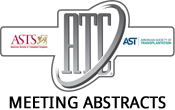2016 American Transplant Congress
Incidence of Post-Transplant Malignancy (PTM) After Pediatric Kidney Transplantation (PKTx).
PURPOSE: Post-transplant immunosuppression is associated with an increase in cancer rates. To date, the long-term incidence of PTM among PKTx recipients has not been well-characterized.METHODOLOGY:…2016 American Transplant Congress
The Heterogenous Genomic Landscape of Unresectable Hepatoblastoma Requiring Liver Transplantation: Prognostic Implications.
Surgery, Children's Hospital of Pittsburgh of UPMC and University of Pittsburgh, Pittsburgh, PA.
Background: Hepatoblastoma, the most common pediatric liver malignancy, is cured by chemotherapy and surgical resection. Locally invasive/multifocal tumors require liver transplantation (LTx). A unique tumor…2016 American Transplant Congress
Stratifying Skin Versus Non-Skin Cancer Risk Post-Kidney Transplantation According to Patient Characteristics.
Introduction Cancer is a significant cause of morbidity and mortality after kidney transplantation but risk differs e.g. non-melanoma skin cancers have a better prognosis compared…2016 American Transplant Congress
Prostate Cancer Characteristics and Outcome in Renal Transplant Recipients: Results from a Contemporary Monocentric Study.
Objective To analyze prostate cancer characteristics in a contemporary monocentric renal transplant recipients (RTR) population and to compare oncological outcome after radical prostatectomy (RP) with…2016 American Transplant Congress
Beyond the Bones – The Association Between Vitamin D, Graft Outcomes and Vascular Disease.
1UPMC, Pittsburgh; 2University of Leeds, Leeds, United Kingdom.
Background: Vitamin D deficiency in KTRs is an emerging theme. The purported associations between Vitamin D deficiency and various metabolic, cardiovascular and non-metabolic adverse events…2016 American Transplant Congress
Long-Term Outcomes After Pediatric Liver Transplantation for Malignant Liver Tumors: Effects of Era and Age.
Background: Hepatoblastoma (HB), hepatocellular carcinoma (HCC), along with hemangioendothelioma, hemangiosarcoma, and angiosarcoma (HHA) are rare tumors in children that are treated with orthotopic liver transplantation…2016 American Transplant Congress
Safety of a Short (One-Year) Waiting Time in Kidney Transplant Candidates Treated for Cancer.
In Norway, a one-year waiting time free of cancer recurrence is required before kidney transplantation. To provide an updated, large-scale assessment of this practice, the…2016 American Transplant Congress
Integrative, Multi-Cohort Analysis of Epstein-Barr Virus (EBV)-Positive and Negative Tumor Samples to Identify Gene-Signatures Associated with EBV Oncogenesis.
Stanford School of Medicine, Stanford, CA.
EBV is linked to a variety of lymphoid and epithelial malignancies. In transplant recipients EBV is associated with the development of B cell lymphomas in…2016 American Transplant Congress
Everolimus Plus Reduced-Exposure Cyclosporin versus Mycophenolic Acid Plus Cyclosporin: Seven-Year Follow-Up of Australia and New Zealand Kidney Transplant Recipients in the A2309 Study.
A2309 was a 2-year, phase III randomized controlled trial evaluating the effect on graft and patient outcomes of three groups:1.5mg everolimus plus low exposure cyclosporine…2016 American Transplant Congress
Outcomes of Solid Organ Transplant Recipients with Pre-Existing Malignancies.
Background: Pre-transplant malignancy (PTM) is considered a relative contraindication for transplantation due to the heightened risk of cancer recurrence associated with immunosuppression. However, little has…
- « Previous Page
- 1
- …
- 15
- 16
- 17
- 18
- 19
- 20
- Next Page »
